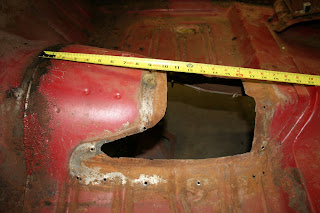1968 -1971 Torino Fairlane Cyclone Bucket Seat Installation and Parts
The two door versions of these cars could be ordered with bucket seats. To properly mount the bucket seats some additional parts were required. There has an additional support of the inner, rear seat track bolts. This U shaped bracket was tack welded in place. The 1968-1969 cars used a special spacer under the front seat track bolts. All cars used spacers under the rear seat track bolts.
During restoration, many find the U shaped bracket to be badly rusted. The seat track spacers are sometimes missing. Also, it is popular to install bucket seats in a bench seat car. These parts are some of the most commonly requested parts. To my knowledge, these parts are not in reproduction.
When parting out cars, I have found the U shaped brackets in some 2 door, bench seat cars. I find the welding on the support brackets to be poor. If installing one of these brackets to concours conditions, it is advisable to have a welder with marginal skills install it.
This is a support bracket in very good condition
This is a front seat track spacer which is used 1968-1969 only
Seat support installed
Cracking around the mounting holes is common.

.JPG)
.JPG)























